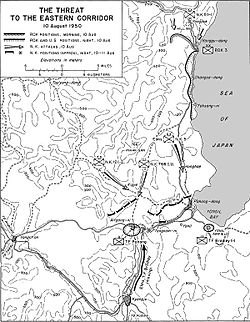NK 766th Infantry Regiment
| 766th Infantry Regiment | |
|---|---|

Map of the 766th Independent Infantry Regiment's final offensive action, August 10, 1950
|
|
| Active | April 1949 – August 19, 1950 |
| Country |
|
| Allegiance |
|
| Branch |
|
| Type | Infantry |
| Role | Amphibious/Commando operations |
| Size | Regiment |
| Garrison/HQ | Hoeryong, North Korea |
| Commanders | |
| Notable commanders |
Senior Colonel Oh Jin Woo |
The 766th Independent Infantry Regiment (Korean: 제766독립보병련대) was a light infantry unit of North Korea's Korean People's Army (KPA) that existed briefly during the Korean War. It was headquartered in Hoeryong, North Korea, and was also known as the 766th Unit (Korean: 766부대). Trained extensively in amphibious warfare and unconventional warfare, the 766th Regiment was considered a special forces commando unit. The regiment was trained to conduct assaults by sea and then to lead other North Korean units on offensive operations, to infiltrate behind enemy lines and to disrupt enemy supplies and communications.
Activated in 1949, the regiment trained for more than a year before the outbreak of the war on June 25, 1950. On that day, half of the regiment led North Korean forces against South Korean troops by land and sea, pushing them back after several days of fighting. Over the next six weeks the regiment advanced slowly down the Korean Peninsula, acting as a forward unit of the North Korean army. Suffering from a lack of supplies and mounting casualties, the regiment was committed to the Battle of Pusan Perimeter as part of a push to force United Nations (UN) troops out of Korea.
The regiment saw its final action at the Battle of P'ohang-dong, fighting unsuccessfully to take the town from U.N. troops. Racked by U.N. naval and air forces and suffering extensive losses from continuous fighting, the regiment was forced to retreat from the P'ohang-dong battlefield. It moved north, joining a concentration of other KPA units, before being disbanded and absorbed into the KPA's 12th Division.
...
Wikipedia
